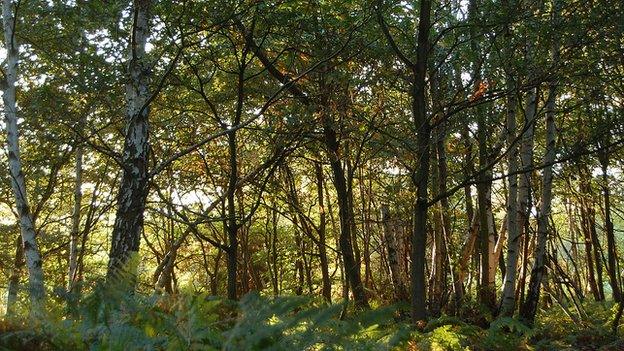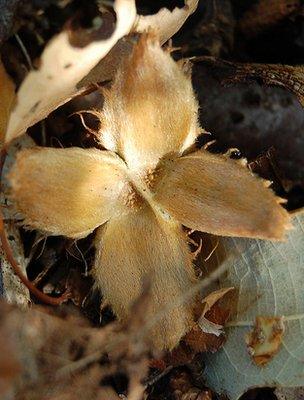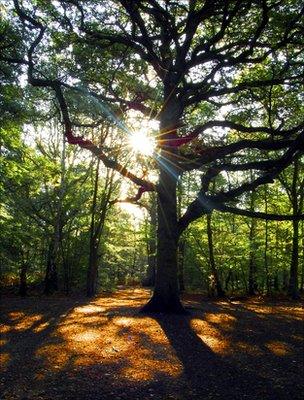'Unprecedented threat' for UK trees from pests
- Published

UK trees are facing an "unprecedented level of threat" from pests and diseases, the Forestry Commission has warned.
All species are vulnerable to potential attacks - from ecologically vital oaks to non-native ornamental species, such as lawson cypresses.
The biggest risk, it warns, comes from non-native organisms, which - in their natural range - are kept in check by natural predators and environmental conditions.
However, if they are able to become established in the UK's natural environment then there are often no natural controls to curb their spread, resulting in a potentially devastating impact on the landscape.

Non-native pests and diseases can affect a woodland's long-term ecology
In October 2011, UK Environment Secretary Caroline Spelman launched the Tree Health and Plant Biosecurity Action Plan, external, warning that millions of trees could be lost in the next few years unless urgent action was taken.
The Commission recently published biosecurity guidance, offering advice on steps that can be taken to avoid accidentally spreading damaging organisms, external on clothes, footwear, vehicles, etc.
"The fact that we are an island has helped us, because we are fairly impoverished compared with the European mainland," explained Hugh Evans, head of Forest Research in Wales.
"So even the 20 miles of water is enough to protect us from the pests that are quite dangerous on the mainland."
But our relative isolation has come at a cost, he warned.
"If pests do get through, then they arrive without the spectrum of natural enemies and that is one element that can make the effect within the arrival country much worse than in the country of origin."
Growing trade
Richard McIntosh from Food and Environment Research Agency (Fera) says the growing volume of international trade is one reason for concern.
"Trade is becoming increasingly global, and there is an ever-widening diversity of plants and plant material being traded around the world," he told BBC News.
"There are examples of where pests or pathogens have been introduced, and it is very difficult to respond to them once they are within the EU.
"Prevention is much better than cure but identifying all of the risks is not always the easiest thing to do."
Probably the most widely publicised pathogen is Phytophthora ramorum, external, a fungal organism which was suspected of being introduced to these shores via the plant trade. There is no treatment; infected trees have to be felled and removed from the natural environment.
Although it had been present at low levels in the UK for a number of years, in 2009 there was a sudden change in the pathogen's behaviour. It was recorded infecting and killing the commercially important Japanese larch trees in South-West England.
It was the first time in the world that P. ramorum had been found on a species of conifer. It has since been recorded affecting larch trees at sites in all four UK nations.
John Morgan, head of the Forestry Commission's Plant Health Service observed: "We are still are pursuing a policy of reducing the level of the disease so then it does not spread further.
"If, over a number of years of felling, we can reduce its spread we can then preserve what we have left in terms of larch in forests."
Dr Morgan added that the disease would not be eradicated: "Once something like that is established then we are purely looking at a policy of containment.
"P. ramorum is definitely in the realms of containment strategies. By the time it was discovered in larches, it was too late."
Experts say the symptoms to look out for on larch trees include dead and partially flushed trees present in groups, patches or distributed throughout a stand. An affected tree's crown and branches die back, and there is a distinctive yellowing or ginger colour beneath the bark.
Unwelcomed guests
Another pest that was introduced to the UK as a result of human activity was the great spruce bark beetle, external.

Introducing a natural predator proved to be an effective control of the great spruce bark beetle
"It clearly came into this country via wood that had not been debarked properly," said Prof Evans.
"What was interesting - and I think this is [a] somewhat typical story - is that although we found it in 1982, our subsequent research found that it had been in the country at least 10 years prior to that."
The beetle breeds under the bark and destroys the cambium (a layer of growing tissue that produces new cells to carry water, sugars and nutrients around the tree). This weakens the tree, and in most extreme cases, the damage can kill the tree.
As part of their research, Prof Evans said scientists quickly identified a possible "bio-control" option. They introduced a natural predator - another species of beetle called Rhizophagus grandis.
"We were able to bring that beetle in to the country; we got the very first licence for the release of a non-native species under the Wildlife and Countryside Act.
"It proved to be incredibly successful," he told BBC News.
"[The great spruce bark beetle] did kill quite a few trees, but after the predator was introduced and we continued to monitor it for a few years, its population has dropped to a relatively low level. It is still spreading, but the predator seems to be following it."
Preventing pests
Dr Morgan said UK control measures involved four stages.

Once a pest or disease becomes established, it becomes virtually impossible to eradicate it
"We try to prevent pest and diseases entering the country; then, if they have arrived, we switch to a policy of eradication to try and stop them becoming established," he said.
"If they do become established then we try and follow a policy of containment which is to try and slow or stop the spread of the pest.
Finally, if all previous three efforts have failed then we operate a way that we can live with the particular pest or disease."
There are a number of ways that scientists are able track the global or regional spread of a pest or pathogen, such as the EU Plant Health Directive, external that requires nations to report new outbreaks or new pathogens.
Another way data is shared among researchers is via bodies such as the European Mediterranean Plant Protection Organization, external and the International Plant Protection Convention, external.
"Both of these organisations have notification systems where countries are able to report developments that might be of wider interest," revealed Fera's Richard McIntosh.
"We monitor that sort of intelligence, together with information that might be coming out via publications, and also what we are finding - such as what we are intercepting at the national borders."
Mr McIntosh said this information is used to produce a document known as a Pest Risk Analysis (PRA), which looks at the risks, possible impacts and control of each organism within a UK context.
Wider impact
Andrew Sharkey, head of woodland management for the Woodland Trust, said the impact of pests and diseases often had ramifications that were felt beyond the individual trees that were infected.

Experts recommend a "watching brief" for UK oaks amid concern of a Dutch elm disease-like outbreak
"Two of our sites have been affect by [Phytophthora ramorum]... so we had to fell the larch on those sites," he said.
"We are comfortable with this because it is good practice but it means that it has disrupted all of the site plans for those sites.
"The larches on one of the sites were on what we call 'planted ancient woodlands', which we were trying to restore back to native woodlands.
"This has an immediate impact on our biodiversity work and planning work."
In 2011, Natural England's Keith Kirby warned that the future well-being of the UK's oak trees was at a crossroads because of the potential threat from a disease known as Acute Oak Decline (AOD), external, which experts warned could be as devastating to the treescape as Dutch elm disease.
Dr Kirby told BBC News that research was helping shed more light on dynamics of the mysterious disease.
"We are becoming more and more certain that it is basically a bacterial issue, and a beetle is involved in its spread. It appears that the problem is also exacerbated if the tree is under stress," he said.
"But we are not that much further along in terms of knowing exactly how abundant or widespread it is.
"At the moment, it does not look as if it has gone beyond the East Midlands and southern England area, where most of the records have come from."
As one of the UK's leading woodland ecologists, Dr Kirby said people had to be philosophical about the fact that the composition of woodlands were going to change.
"We cannot attempt to maintain the mixtures that existed in the past," he observed. "We have to accept that there will be change, and manage the dynamic situation.
"If you have got a changing environment, you cannot expect the communities and assemblages of species of past environments to survive."
- Published27 October 2012
- Published14 September 2011
- Published20 October 2011
- Published28 April 2010
- Published21 April 2010
- Published1 April 2012